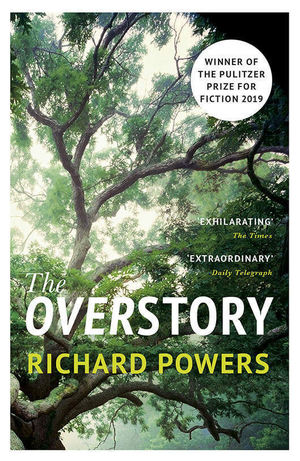In the 1980s and ’90s, as the whir and scream of chainsaws echoed throughout the old-growth forests of the American Northwest, protesters converged to stop the clear-cutting of the last stands of some of Earth’s tallest and oldest trees. They stood between machine and primal nature. Some climbed the ancient giants and camped for months in their upper limbs to protect them from destruction. Some demonstrations turned violent as the Timber Wars of the Pacific Northwest became a proving ground for conflict among environmentalists, industry and the people whose livelihoods depended upon the lumber business.
Those of us paying little attention back then to those north woods provocations might at least recall headlines focused on the movement’s symbolic icon — the spotted owl.

While this episode in American history serves as the fulcrum for Richards Powers’ The Overstory, the 502-page novel ranges far beyond these events. In fact, the standoff in the woods does not enter into the book’s sprawling narrative until well into the storytelling. Until then, the author masterfully creates the life stories of eight or nine characters — a random medley of people drawn into those hostilities for various reasons. In the book’s homestretch, Powers examines the impact that their acts of bravery — or foolhardiness — have had on their lives going forward.
While that provides the book’s structure, much of its texture, richness and authenticity comes from the skillfully drawn characters. There is the Hoel family whose 19th-century settling into Iowa’s heartland soil tells of the great American migration saga — and that of the chestnut tree. There is Mimi Ma whose precious heirloom persists in connecting her to her family’s Chinese roots. There, too, is Douglas Pavlicek whose fall from the C-130 into the trees of Laos ends not in death but a kind of redemption; he later plants seedlings of Douglas fir to replace those being cleared.
And there are the quirky Adam Appich and the party girl Olivia Vandergriff, whose life is a kind of second life, and Neelay Mehta who creates alternate universes in the video games he designs, and Ray and Dorothy whose relationship gives Powers plenty of room to examine the competing quandaries of love. Each chapter carries the weight and complexity of a novel — and the truths of human nature. And human culture and civilization.
The book’s most compelling character may be Patricia Westerford, the misfit little girl who turns to the woods for companionship and becomes a scientist who unlocks the secrets of trees. Some suspect Westerford is based on Suzanne Simard, the professor of forest ecology at the University of British Columbia whose work has revolutionized the way trees are studied and perceived.
As finely drawn as are the characters, as engaging as are their stories and as richly observed as is Powers’ take on modern life, The Overstory brims with accessible science, the charms of botany and the tapestry of life on Earth — the relationships between humans and plant life. The research that Powers undertook to write this fictional narrative is impressive — and a delight.
“Patricia gives herself to Douglas firs,” writes Powers. “Arrow straight, untapering, soaring up a hundred feet before the first branch. They’re an ecosystem unto themselves, hosting more than a thousand species of invertebrates. Framer of cities, king of industrial trees, that tree that without which America would have been a very different proposition. . . . The largest of them must be six centuries old. He’s so tall, so near the upper limits imposed by gravity, that it takes a day and a half for him to lift water from his roots to the highest of his sixty-five million needles. And every branch smells of deliverance.”
The writer Margaret Atwood has compared Powers’ scope and range in this vast work to Herman Melville and his classic Moby-Dick. The novel feels that big. It won the Pulitzer Prize for Fiction in 2019. Powers’ The Echo Maker was awarded the National Book Award for Fiction in 2006.
For readers looking for tidy, unambiguous resolutions, this book will disappoint. As a writer friend said to me, the book is closer to realism than fantasy. Some may not feel settled with the way things turn out for certain characters. A couple of events remain unclear, even puzzling. A suggestion or two of happenings more supernatural than scientific remain as you come to the book’s final page . . . and keep thinking . . . as things go on, sometimes not as we want, but the way life really happens.
Kerry Temple ’74 is editor of this magazine.